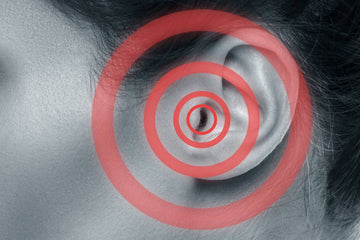Conductive vs Sensorineural Hearing Loss: Causes and Symptoms
by Hear Clear on Nov 19, 2023

Hearing loss is a common condition that affects millions worldwide, and it’s news to nobody that it can significantly impact the quality of life of those who suffer from it. But just like there are many different types of hearing aids, there are also different forms of hearing loss, and understanding the difference between the two can be useful when it comes to managing symptoms and choosing treatments.
Generally, hearing loss is primarily classified into two types: conductive and sensorineural hearing loss - but what’s the difference between the two? In the following article, we’re going to explain the difference between conductive hearing loss and sensorineural hearing loss, while taking a look at causes, and symptoms of both, giving you a comprehensive understanding of their differences and the implications of each. Let’s take a look.
What is Conductive Hearing Loss?
Put simply, conductive hearing loss occurs when sound waves are hindered from reaching the inner ear, and this blockage can happen in the outer or middle ear, often due to physical obstructions or malfunctions. Common causes include ear infections, fluid in the middle ear, earwax buildup, perforated eardrums, and abnormal bone growth in the middle ear (medically known as otosclerosis).
Symptoms of Conductive Hearing Loss
Symptoms of conductive hearing loss are varied, but patients may experience a reduction in sound level or an inability to hear faint sounds. Ear pain, a feeling of fullness in the ear, and a noticeable change in their own voice (sounding muffled or dull) are also common, but in many cases, these symptoms can be alleviated or reversed with medical treatment or surgery.
What is Sensorineural Hearing Loss?
Sensorineural hearing loss, the most common type of permanent hearing loss, arises from problems in the inner ear or the auditory nerve, which connects the inner ear to the brain. Damage to the hair cells in the cochlea (part of the inner ear) or the nerve pathways is often irreversible, and the leading causes include ageing, exposure to loud noise, head trauma, viral infections (such as mumps or measles), and genetic predispositions.
Symptoms of Sensorineural Hearing Loss
 The symptoms of sensorineural hearing loss tend to be more severe than those of conductive hearing loss, and patients may struggle with understanding speech, especially in noisy environments, and often complain that sounds seem muffled or unclear. Tinnitus (a ringing or buzzing in the ears) and dizziness can also accompany this type of hearing loss. Unfortunately, sensorineural hearing loss is generally permanent, and treatment usually focuses on managing the condition, such as through hearing aids or cochlear implants.
The symptoms of sensorineural hearing loss tend to be more severe than those of conductive hearing loss, and patients may struggle with understanding speech, especially in noisy environments, and often complain that sounds seem muffled or unclear. Tinnitus (a ringing or buzzing in the ears) and dizziness can also accompany this type of hearing loss. Unfortunately, sensorineural hearing loss is generally permanent, and treatment usually focuses on managing the condition, such as through hearing aids or cochlear implants.
Conductive vs Sensorineural Hearing Loss: Key Differences
Severity
Conductive hearing loss stems from physical blockages or abnormalities in the outer or middle ear, and this often leads to reversible or treatable conditions. In contrast, sensorineural hearing loss originates from damage to the inner ear or auditory nerve and is usually permanent.
Causes
As we mentioned earlier, the causes of these two types of hearing loss are distinctly different. Conductive hearing loss can result from infections, earwax buildup, or physical trauma, whereas sensorineural hearing loss is often related to ageing, prolonged exposure to loud noise, or genetic factors.
Symptoms
Symptomatically, conductive hearing loss usually presents a reduction in sound levels and an alteration in sound quality, and the good news is these symptoms can often be resolved with medical intervention. On the other hand, sensorineural hearing loss leads to a permanent decrease in sound clarity and difficulty in understanding speech, often requiring long-term management strategies like hearing aids.
What's the difference in treatment for Conductive and Sensorineural Hearing Loss?
Given their different pathologies, the treatment strategies for conductive and sensorineural hearing loss differ significantly:
Treatment for Conductive Hearing Loss
Medical Treatment
Often, conductive hearing loss is caused by temporary conditions like ear infections or earwax blockage, and these can usually be treated medically. For instance, ear infections may require antibiotics, while earwax blockage can be resolved through professional cleaning.
Surgical Treatment
Some cases of conductive hearing loss, such as those caused by otosclerosis (abnormal bone growth) or a perforated eardrum, might require surgical intervention. Procedures like tympanoplasty (repairing a perforated eardrum) or stapedectomy, aka surgery for otosclerosis, can be effective.
Hearing Aids
In situations where medical or surgical treatments are not feasible or fully effective, patients can buy hearing aids which can be beneficial for their hearing. These devices amplify sound, helping to overcome the blockage in the outer or middle ear.
Treatment for Sensorineural Hearing Loss
Hearing Aids
For most people with sensorineural hearing loss, hearing aids are the primary treatment option; these devices can amplify sound, helping to compensate for the damage to the inner ear or auditory nerve.
Cochlear Implants
In severe cases of sensorineural hearing loss, especially where hearing aids are not effective, cochlear implants may be an option: these devices bypass damaged parts of the ear and directly stimulate the auditory nerve.
Management Strategies
Since sensorineural hearing loss is often permanent, treatment also focuses on management strategies. This can include - but isn’t limited to - training in lip-reading, using assistive listening devices, and employing techniques to improve communication in noisy environments.
Medication and Surgery
In some specific cases, such as sensorineural hearing loss caused by certain diseases or infections, medications or surgical interventions might be applicable. However, these are less common and depend on the underlying cause.




